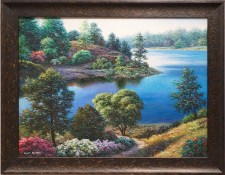Peeters, Henry

The Impressionist landscapes and interiors of Henry Peeters reveal an artist with a strong sensibility towards color, classical composition and a fresh insight into contemporary painting. Peters' painting style is unique and personal. What attracts one immediately is the light, as it pours out of each canvas and emanates from the objects themselves.
The wide range of the artist's subjects are steeped in this tempered light, delicately bathed in fine impasto, the surrounding landscapes rich in color.
The artist's country scenes in particular, exhibit strong interplay of volume and light The oil is used to the fullest; both it?s color and texture are incorporated into the form of leaves, wood, stone and brick by Peters' exceptional control of his medium. Peeters stands apart from many of today's painters by possessing the unique ability to renew the language of Impressionism.
Drawing from Western culture's classic traditions, he provides us with a refreshing and new vision of the modern world. The great success Peeters' paintings have found in America is testimony to his great skill as an artist. Henry Peeters spent the next two years exhibiting his work in major cities throughout China and received many national awards.
In 1974 Henry Peeters became an art director and set designer for a prominent film studio. In 1978 he made the bold move to the United States where he found immediate representation.
The artists's chosen subjects were realistically depicted cityscapes and interior scenes, much in the style of Edward Hopper whom he greatly admires. Still using his given name, Hing Biu found that his paintings were well appreciated and eagerly collected. Yet after years of continued and proven success, he soon found a need to create a new challenge for himself. In effect, he felt that his versatility had gone untested as he quickly established his reputation in the American art scene.
Moving from the flat surface of his realistic paintings, Peeters gradually began working with various palette knife techniques to develop his current style of impasto, impressionist painting. Initially reluctant to sign his own name for fear that the public would not agree to the idea that an artist could work in two such different styles, he whimsically chose the name that would soon out shadow his own: Henry Peeters.
With his unique handling of light and shadow, Henry Peeters stands apart from today's Impressionist painters. His sensibilities in color and composition are evident of his utmost achievement and ability.
Drawing from both eastern and western cultures, he provides us with a refreshing and new insight towards the world we live in. He creates an almost ideal setting for the viewer to relax. Peeters paints mostly from memory and emotion. His landscapes are places that can only be visited in the mind, since they are blends of the real and imaginary. Having his work recognized throughout the world has come as somewhat of a surprise to this shy, unassuming painter.
Henry Peeters actually feels uncomfortable with the admiration that has come to him during the past several years. On the other hand he is able to enjoy that his paintings bring joy to the many people who have collected the work throughout the years.